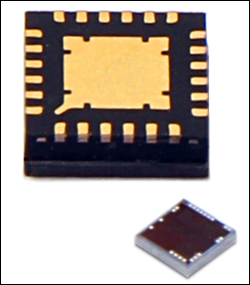Several companies are trialing sample versions of a passive ultrahigh-frequency (UHF) RFID sensor tag designed to enable users to capture data such as temperatures, strain or weight, using a standard, off-the-shelf UHF RFID reader. Integrated circuit (IC) design company Asygn (pronounced “assign”) released samples of its AS321X chip this month. The chip is expected to be made commercially available by the second half of this year, and Asygn says users will initially be centered in the automotive, industrial Internet of Things (IoT), aeronautics and logistics industries.
This is Asygn’s first RFID chip. The company was launched a decade ago to provide design services for ICs specific to sensors, sensor interfaces and RF technology. In recent years, says Nicolas Delorme, Asygn’s CTO, some of the firm’s customers have been seeking a wireless alternative to the sensors they used to monitor conditions within their facilities. According to Delorme, these companies wanted wireless sensors that would be able to operate not only without a power connection, but without a battery.
Although companies sell other sensor-based UHF RFID tags, Delorme says, Asygn’s customers have reported that they were unsatisfied with the read range or sensor performance provided. These RFID-based sensors also required specialized readers or firmware to manage the sensor data, the company found. Asygn has spent the past two years developing its own solution. “Our main focus the is design of ICs for sensors and RF activations,” he states.
The company describes the AS321X tag as a fully passive UHF RFID sensor chip, with a temperature sensor integrated on the silicon, as well as an ultra-low-power analog sensor interface that includes an instrumentation amplifier that acts as a connector to the RFID chip, enabling the seamless capture of sensor data at the time the tag is interrogated. Asygn plans to embed other internal sensors into the RFID chips as well, to measure strain, acceleration, hall effect (for magnetic fields), ambient light and contact, according to Lionel Geynet, the company’s RFID and RF project manager.
Users of the AS321X can employ an off-the-shelf UHF RFID reader to transmit its interrogation signal to the tag, and the energy from that signal will power the sensor and the tag’s RF response. That means companies already using RFID to track the identities and locations of goods could employ their existing infrastructure to capture sensor data along with the unique ID.
Automotive companies are testing the new ICs for the purpose of condition monitoring, Geynet reports. Measurements of conditions around parts, such as temperature levels, may enable them to detect component failures after the assembly and finishing processes. The tags could also be used with pressure sensors to identify mechanical strain, or to monitor humidity levels in order to detect a leak in an engine, for instance.
Aeronautics companies similarly are using the chips to test the conditions around aircraft parts—not only after assembly at the manufacturing site, but once an aircraft is in operation—for the purpose of monitoring maintenance operations. Since RFID tags are already in place for many aeronautical and airline industry members, the new tags could enable maintenance personnel to undergo the same process of interrogating the tags to identify parts, while collecting data regarding condition and performance.
Another market could be logistics or cold supply chain goods, provided a system were in place to interrogate the passive tags at key points during transit or storage processes. Asygn predicts that its sensor chip will provide value in scenarios for which such technology has previously proven unsuccessful.
“What’s special is the on-chip [data] acquisition interface,” Delorme says, which enables any transducer to be linked to a chip, with low power consumption. The chip’s reading distance, he adds, is high for a sensor device, with a range of a few meters. In fact, he says, it provides the same range that one might achieve using a standard non-sensor-based RFID tag. Data can be captured at a rate of a few milliseconds, Delorme reports.
The AS321X chip is designed to be robust in challenging environments, with high stability during the measurement of temperature, motion or other conditions, “due to how we implement this acquisition channel, which guarantees we have a very stable measurement,” Delorme states. “What we think we bring is a new category of applications: sensing without wires or battery.”
The cost of the tag will be higher than that of a standard inventory-tracking RFID tag, though the company has not yet estimated the commercial price. Among the businesses currently testing the chips are system integrators, as well as end users themselves. Most customers are located in Europe, though samples are being provided to customers and partners globally.
Upon request, Asygn can provide antenna and tag designs for qualified partners. The company says it can also supply mobile and desktop applications and database-management libraries for use by systems integrators or end users, to let them more quickly develop the solution.
Other passive UHF RFID sensor tags are provided by Farsens (see Spanish Startup Focuses on Passive RFID Sensors for Manufacturing and Other Industries) and Axzon, formerly known as RFMicron (see Smartrac, RFMicron Release Passive RFID Temperature Sensor Technology).




